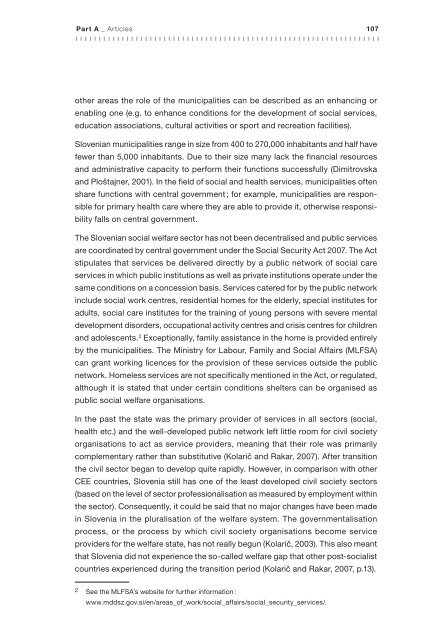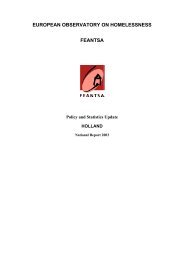Part A - Feantsa - Horus
Part A - Feantsa - Horus
Part A - Feantsa - Horus
Create successful ePaper yourself
Turn your PDF publications into a flip-book with our unique Google optimized e-Paper software.
<strong>Part</strong> A _ Articles<br />
other areas the role of the municipalities can be described as an enhancing or<br />
enabling one (e.g. to enhance conditions for the development of social services,<br />
education associations, cultural activities or sport and recreation facilities).<br />
Slovenian municipalities range in size from 400 to 270,000 inhabitants and half have<br />
fewer than 5,000 inhabitants. Due to their size many lack the financial resources<br />
and administrative capacity to perform their functions successfully (Dimitrovska<br />
and Ploštajner, 2001). In the field of social and health services, municipalities often<br />
share functions with central government ; for example, municipalities are responsible<br />
for primary health care where they are able to provide it, otherwise responsibility<br />
falls on central government.<br />
The Slovenian social welfare sector has not been decentralised and public services<br />
are coordinated by central government under the Social Security Act 2007. The Act<br />
stipulates that services be delivered directly by a public network of social care<br />
services in which public institutions as well as private institutions operate under the<br />
same conditions on a concession basis. Services catered for by the public network<br />
include social work centres, residential homes for the elderly, special institutes for<br />
adults, social care institutes for the training of young persons with severe mental<br />
development disorders, occupational activity centres and crisis centres for children<br />
and adolescents. 2 Exceptionally, family assistance in the home is provided entirely<br />
by the municipalities. The Ministry for Labour, Family and Social Affairs (MLFSA)<br />
can grant working licences for the provision of these services outside the public<br />
network. Homeless services are not specifically mentioned in the Act, or regulated,<br />
although it is stated that under certain conditions shelters can be organised as<br />
public social welfare organisations.<br />
In the past the state was the primary provider of services in all sectors (social,<br />
health etc.) and the well-developed public network left little room for civil society<br />
organisations to act as service providers, meaning that their role was primarily<br />
complementary rather than substitutive (Kolarič and Rakar, 2007). After transition<br />
the civil sector began to develop quite rapidly. However, in comparison with other<br />
CEE countries, Slovenia still has one of the least developed civil society sectors<br />
(based on the level of sector professionalisation as measured by employment within<br />
the sector). Consequently, it could be said that no major changes have been made<br />
in Slovenia in the pluralisation of the welfare system. The governmentalisation<br />
process, or the process by which civil society organisations become service<br />
providers for the welfare state, has not really begun (Kolarič, 2003). This also meant<br />
that Slovenia did not experience the so-called welfare gap that other post-socialist<br />
countries experienced during the transition period (Kolarič and Rakar, 2007, p.13).<br />
2 See the MLFSA’s website for further information :<br />
www.mddsz.gov.si/en/areas_of_work/social_affairs/social_security_services/.<br />
107




